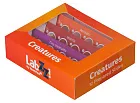Bresser Erudit Basic Mono 40–400x Microscope
Magnification: 40–400x
| Product ID | 70333 |
| Brand | Bresser GmbH, Germany |
| Warranty | 2 years |
| EAN | 4007922030760 |
| Package size (LxWxH) | 36x23x50 cm |
| Shipping Weight | 5.8 kg |
Bresser Erudit Basic Mono 40–400x Microscope is a high-quality tool that can be successfully used in schools, universities, or at home. The microscope can be powered by batteries, allowing you to use the instrument anywhere. Available magnifications (40x, 100x and 400x) allow the device to be used for studying thin sections, aquatic organisms, blood or bacterial swabs. It is also suitable for the detection of parasites of domestic animals (coccidia, helminths; skin and fur parasites).
Achromatic DIN-objectives allow you to receive very high-quality images. The 40x lens is spring-loaded to prevent any damage to the lens or sample during focusing.
The microscope comes in a practical body, which is also equipped with a smartphone holder, allowing you to make photos and videos of observed samples on your smartphone.
Features:
- Biological microscope for observation in transmitted light
- LED illumination
- Coarse and fine focus, coaxial
- x-y stage for precise positioning
- Adjustable Abbe condenser
- 360° rotatable monocular head
- Case for storage and transportation
The kit includes:
- Bresser Erudit Basic Mono 40–400x Microscope
- WF10x Eyepiece
- Achromatic DIN-Objectives (4x, 10x, 40x)
- Abbe-Condenser, adjustable, with diaphragm and filter holder
- Smartphone holder
- Case for storage and transportation
- Prepared slides, blank slides and cover slips
| Product ID | 70333 |
| Brand | Bresser GmbH, Germany |
| Warranty | 2 years |
| EAN | 4007922030760 |
| Package size (LxWxH) | 36x23x50 cm |
| Shipping Weight | 5.8 kg |
| Type | biological |
| Microscope head type | monocular |
| Head | 360 ° rotatable |
| Magnification, x | 40 — 400 |
| Eyepieces | WF10x |
| Objectives | 4x, 10x, 40x |
| Condenser | Abbe N.A. 1.2 centered, height adjustment |
| Focus | coaxial with coarse and fine adjustment |
| Illumination | LED |
| Light source type | lower illumination |
| Additional | smartphone holder |
| Application | school/educational, laboratory/medical |
| Illumination location | dual |
| Research method | bright field |
| Pouch/case/bag in set | case |
We have gathered answers to the most frequently asked questions to help you sort things out
Find out why studying eyes under a microscope is entertaining; how insects’ and arachnids’ eyes differ and what the best way is to observe such an interesting specimen
Read this review to learn how to observe human hair, what different hair looks like under a microscope and what magnification is required for observations
Learn what a numerical aperture is and how to choose a suitable objective lens for your microscope here
Learn what a spider looks like under microscope, when the best time is to take photos of it, how to study it properly at magnification and more interesting facts about observing insects and arachnids
This review for beginner explorers of the micro world introduces you to the optical, illuminating and mechanical parts of a microscope and their functions
Short article about Paramecium caudatum - a microorganism that is interesting to observe through any microscope






